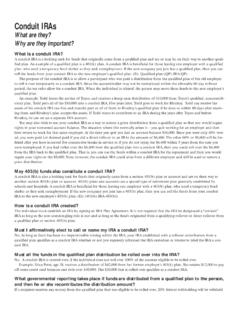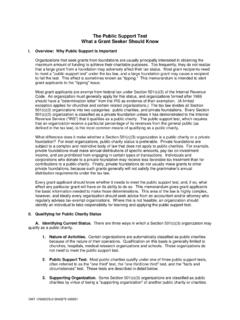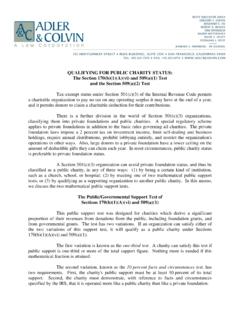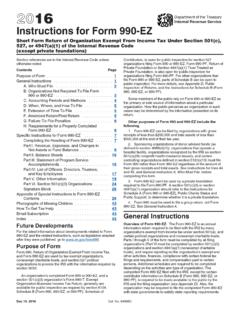Transcription of IRAs Gifting IRA Funds to the Church - Loretto, …
1 Questions & Answers IRAsGifting IRAF unds tothe ChurchPurposeThe purpose of this brochure is to explain a new charitable con-tribution federal income tax law which allows certain IRAaccountholders to give tax-free donations directly from their IRAto a qualifying charity. We want you to be informed concerningthis tax-free IRA distribution option, should you decide to donateIRA Funds to the Church . The authority for this new law is thePension Protection Act of 2006, which was signed into law onAugust 17, 2006. This new law will primarily benefit traditionalIRA accountholders; however, certain distributions from RothIRAs are also is the benefit of the new law?In general, a person age 701 2or older will be able to direct his orher IRA custodian to withdraw an amount of up to $100,000from his or her IRA and have such proceeds sent directly to aqualifying charitable organization.
2 The distribution will be taxfree if certain rules are the existing tax rules, approximately two-thirds of taxfilers use the standard deduction and are unable to claim adeduction for their charitable contributions. There are many peo-ple over age 701 2who use the standard deduction. There willnow be an incentive for these individuals to withdraw Funds fromtheir IRA, because excluding an amount from one s income is theequivalent of claiming a tax there a time period within which the qualifiedcharitable contribution must be made?Yes, this new law is effective with respect to distributions made intax years beginning after December 31, 2005, and by December31, 2007, unless a subsequent law would be passed to extend requirements must I meet in order to takeadvantage of this charitable contribution law?1. You must be age 701 2or You must have a traditional or Roth You must itemize deductions on your Form 1040 income Your contribution to a qualifying charity must also have beenable to qualify as an itemized deduction, but for this specialcharitable contribution rule under Code section 170 (disregardthe percentage limits).
3 Caution:You receive the tax-free char-itable contribution treatment only if the entire amount wouldhave qualified as a charitable deduction. Thus, if the contribu-tion amount is reduced because of a benefit received by youin exchange, or because the custodian does not obtain suffi-cient substantiation, the exclusion is not available with respectto any part of the IRA The distribution, but for this rule, must otherwise have beenrequired to be included in your gross income. The withdrawalof basis ( nondeductible contributions) from a traditionalIRA is not includable in income, and consequently, such with-drawal does not qualify as a tax-free charitable contribution. Ifthe withdrawal from a Roth IRA will not be taxed because it iseither the withdrawal of basis or because the distribution is aqualified distribution, such withdrawal does not qualify as atax-free charitable Payment, no matter in what form (electronic transfer, check,etc.)
4 , must be made directly from the IRA to the qualifyingcharitable organization. The instrument used for payment mustnot be negotiable by the IRA there a limit on the amount which can be contributed to a charity each year?Yes, you may contribute up to a maximum of $100,000 each yearto a qualifying charity for years 2006 and my spouse and I both make this type of contribution?If you and your spouse have separate iras , you may each con-tribute the maximum of $100, I have two or more iras , may I contribute $100,000 from each one?No, the maximum you can contribute per year is $100,000. Thismaximum is per person, NOT per IRA. Will the amount I contribute under this distribution option count toward my required minimum distribution (RMD) for the year?Yes, any amount distributed as a qualifying charitable contribu-tion in 2006 and 2007, will be counted toward your RMD for theapplicable I deduct this contribution on my Schedule A as a charitable contribution?
5 No, any amount which you donate to charity under this newcharitable contribution rule cannot be deducted as an itemizeddeduction for that year on Schedule A of your Form 1040 incometax I took my RMD prior to enactment of the Pension Protection Act, can I make a tax-freecharitable contribution using my RMD Funds now?No. There is no authority stating that this provision of the PensionProtection Act is retroactive to any date earlier than August 17,2006. You may, however, make a tax-free charitable contributionusing additional IRA Funds , up to the $100,000 it benefit me to have the distribution comefrom my Roth IRA rather than my traditional IRA?Roth distributions are always tax free if the 5-year rule has beenmet and the accountholder is age 591 2or older. Therefore, if youhave meet those requirements, you will not need to use this newrule in order to have a tax-free distribution.
6 It will benefit you touse this new rule only if the distribution from your Roth IRAwould be deemed a nonqualified Tax Benefits to the IRA AccountholderIn the case of a distribution of Funds from a traditional IRA, thespecial pro rata taxation rule as set forth in Code section 72 forIRAs is not to be used. In the case of a nonqualified distributionfrom a Roth IRA, the standard ordering rules (annual contribu-tions, conversion contributions, and then earnings) will not , the distribution is treated as consisting of income first,up to the aggregate amount that would be includable in grossincome (but for this provision) if the aggregate balance of all IRAswere distributed during the same year. Proper adjustments in cal-culating the tax treatment of future distributions are to be madeto reflect the fact that taxable income was transferred to thecharity.
7 These distributions which were excluded from grossincome are not taken into account in determining the deductionfor charitable contributions under section Sue Panko has an aggregate total of $100,000 in hertwo traditional iras . Her basis is $20,000. Sue has $90,000 withIRA trustee #1, and the other $10,000 with IRA trustee #2. HerRMD for 2006 is $7,500. Sue decides she wishes to give $40,000to the Red Cross. Sue instructs IRA trustee #1 to send $40,000 tothe Red Cross on September 10, 2006. This is done by the endof September. How will this payment get treated on her 2006federal income tax return?The $40,000 will be excluded from her income. The $60,000which remains in her traditional IRA will still have a basis of$20,000. Presumably, the IRS will be modifying the Form 8606so that Sue can properly reflect these $40,000 distribution is not considered in determining theamount of Sue s charitable tax deduction for the charities qualify in order for the IRAdistribution to be tax free for the accountholder?
8 The so-called 50-percent organizations, as defined in Code sec-tion 170(b)(1)(A) will qualify. However, the supporting organiza-tions described in Code section 509(a)(3) are excluded, as aredonor advised Funds . The qualifying 50-percent organizationsare: churches, a convention or association of churches, educa-tional institutions, hospitals, organizations supporting govern-ment schools, medical research organizations, governmentalunits, publicly supported organizations, common fund founda-tions, certain private operating foundations, and conduit founda-tions. Publication 526, Charitable Contributions, lists the follow-ing organizations as being the most common:1. Churches, synagogues, temples, mosques, and other religiousorganizations. Be aware that our Church is a qualifying entityto receive such Federal, state, and local governments, if your contribution issolely for public purposes (for example, a gift to reduce thepublic debt).
9 3. Nonprofit schools and Public parks and recreation Salvation Army, Red Cross, CARE, Goodwill Industries, UnitedWay, Boy Scouts, Girl Scouts, Boys and Girls Clubs ofAmerica, War Veteran s given to a private foundation does not qualify asa tax-free charitable contribution since a private foundation isnot a public charity. Also, a distribution used to fund a charita-ble remainder trust or gift annuity does not qualify as a tax-freecharitable do I make a qualifying tax-free charitable contribution to the Church ?If you wish to make a tax-free donation from your IRA to thechurch, please contact the Church office. We have a form avail-able for you to complete, which gathers the required instruction to withdraw the Funds from your IRA and paythem directly to the Church mustbe in writing. We believe mostIRA custodians will find this form acceptable authorization to per-form this transaction for you.
10 If not, your IRA custodian will haveits own form for you to :This distribution, in general, will also be able to beused to satisfy your RMD for 2006 and/or the charitable distribution be made from a SEP-IRA or SIMPLE-IRA?Distributions from SEP- iras or SIMPLE- iras are ineligible for thisspecial treatment, as are distributions from qualified plans andother types of retirement , unless the IRS would decide otherwise, it would bepossible to roll over Funds from a SEP-IRA, SIMPLE-IRA (after thetwo-year holding period has been met), and other types of retire-ment plans to a traditional IRA and then make the charitable con-tribution from the traditional special IRS reporting required?The IRS has not yet given any guidance on this subject. A Form1099-R will most likely need to be prepared, listing the individ-ual as the recipient. It will also most likely be up to you, theaccountholder, to indicate, probably on Form 8606, as to why thecharitable distribution is not I discuss this subject with my legal or tax advisor to make sure I qualify for this special tax treatment?








